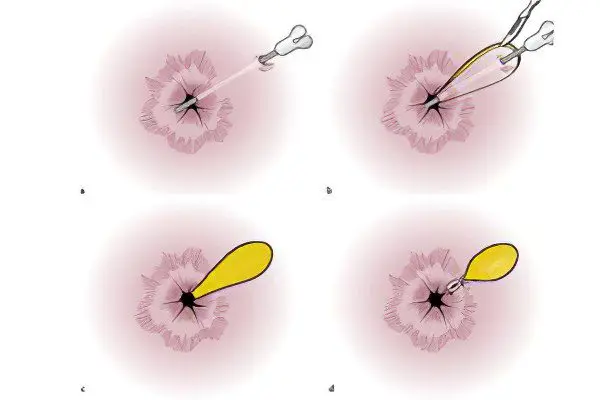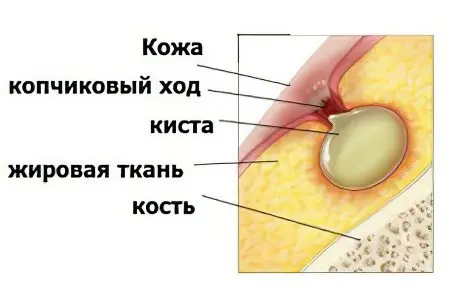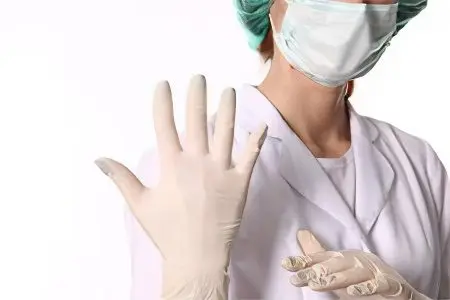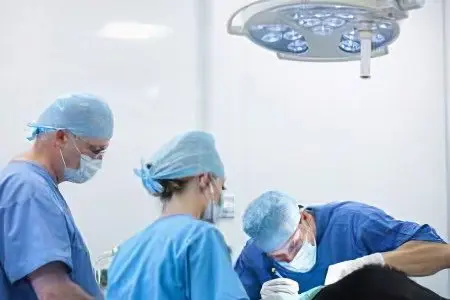Contents
A fistula is a channel that connects a body cavity or hollow organs with the external environment or with each other. Another fistula is called a fistula. Most often, it is represented by a narrow tubule, which is covered from the inside with epithelium or young connective tissue.
Fistulas can form against the background of various pathological processes occurring in the body, as well as after surgery.
Types of fistulas

Fistulas are distinguished depending on their location in the body:
Gastric fistula.
Rectal fistula. It, in turn, is divided into anorectal (from the anus or rectum to the skin) and pararectal (coming out of the anal crypt to the skin).
Rectovaginal fistula that penetrates the rectovaginal septum in women.
Duodenal fistula that affects the duodenum.
Bronchial fistula, which connects the lumen of the bronchi with the pleura, etc.
Depending on the origin of the fistula, it can be acquired or congenital. Congenital fistulas are formed during the intrauterine development of the fetus in the presence of any defects. More often than others, there are median and lateral fistulas of the neck, as well as fistulas of the navel. Acquired fistulas occur against the background of any pathological process, they can also be the result of trauma or surgery.
Sometimes doctors form fistulas on their own to improve the functioning of an organ if it is not possible to remove it. For example, for the outflow of urine, for the passage of the internal contents of the stomach, etc. Such fistulas are called “stoma”.
Depending on whether the fistula is combined with the external environment, it can be external or internal.
External fistulas connect organs or pathological foci of infection of tissues (bones) located in the human body with the external environment. They are most often formed in various infectious diseases (pararectal, urinary, intestinal, osteomyelitic fistula).
Internal fistulas connect organs to each other or to another cavity. For example, there are gastrointestinal, bronchial-pleural and other types of fistulas. They are formed during the disintegration of tissues against the background of pathological processes. When nearby organs are glued and fused with each other, then their gaps are connected to each other.
Depending on the structure, fistulas are granulating, epithelializing and labial.
Depending on what content is separated from the canal, fistulas are salivary, urinary, purulent, mucous, cerebrospinal fluid, fecal, etc.
The structure of the fistula

External fistulas always have two mouths: external and internal, which are connected to each other by a canal. Sometimes the channel may be missing. In this case, the wall of the organ is adjacent to the skin, or even protrudes above it.
Granulating fistulas are covered with granulation tissue. They are pathological, as they are formed against the background of inflammatory processes. The mechanism of their development is as follows:
The inflammatory focus is delimited from the surrounding tissues, after which it breaks out.
Due to the breakthrough that has occurred, a channel is formed through which the pathological contents exit.
Over time, the canal becomes covered with granulation tissue, and connective scar tissue forms around it. The walls of the fistula become immobile and thicken.
Such a fistula does not heal because some kind of discharge constantly passes through it. If it has a chemically active formula, then this will destroy the granulations and promote the penetration of toxins and microbes into neighboring tissues. As a result, scars will form around the fistula. In addition, suppuration of fistulas is fraught with the fact that abscesses and new phlegmon can form other fistulas that open in adjacent tissues. If the pathological contents cease to pass through the fistula channel, then it can heal on its own.
Epithelized fistulas are those fistulas, the canal walls of which are covered with epithelium. When the epithelium of the mucous membrane of the internal organ passes to the skin, then such fistulas are called labial. This name was given to fistulas due to the fact that their wall protrudes above the skin and resembles a human lip in appearance. Most often, such fistulas are formed artificially. Self-epithelialized fistulas cannot heal.
As for the discharge that comes out of the fistula cavity, it depends on which organ the fistula is associated with. The more aggressive this exudate, the more the skin around the fistula will be damaged. For example, with intestinal fistulas, the skin is very quickly corroded and covered with ulcers.
Fistulas are dangerous because they can lead to disturbances in the functioning of the body. In addition, they are formed against the background of the inflammatory process, which means that their development is accompanied by intoxication and fluid loss. All the same intestinal fistulas cause the outflow of digestive fluid. In the future, this leads to a violation of the water-salt balance and metabolic failures.
If the pathological changes in the body are very pronounced, then there is a risk of death of the patient.
Fistula symptoms

The clinical picture that characterizes the presence of a fistula depends on what exactly caused its formation and where it is located.
An external fistula is indicated by the presence of a hole in the skin, from which fluid is released. The appearance of this hole can be preceded by trauma to the corresponding area, inflammatory processes in nearby tissues and organs, as well as surgery.
The condition of the skin around it will depend on what kind of contents is released from the mouth of the fistula. Dermatitis is usually observed near the gastric and duodenal fistula, as the skin is corroded by digestive juices. Next to the urinary fistulas, the skin is edematous, and later elephantiasis is formed.
As for the general reaction of the body, it can vary significantly. Deterioration of the condition will be observed when pathogenic microorganisms penetrate through the fistula and a secondary infection develops. The severe course of the disease is characteristic of purulent fistulas.
Internal fistulas are most often the result of complications of diseases of a chronic or acute course. For example, blockage of the bile ducts by a calculus can lead to the formation of biliary fistulas. In this case, the symptoms will depend on how much bile is secreted into the peritoneal cavity daily. A person may suffer from severe pain in the abdomen, from failures in the digestive process.
If a person has broncho-food fistulas, then they may be indicated by chronic aspiration pneumonia or bronchitis, which occur against the background of food pieces entering the tracheobronchial tree.
If we consider fistulas of the rectum, then the following symptoms will indicate their presence:
There will be a hole in the anus. It is most often barely noticeable. Fluid will constantly be released from this hole, possibly with pus. For this reason, a person will have to wear a pad.
There will be pain in the anus. During a bowel movement, they always increase.
If a patient has a fistula formed on the gum, then the clinical picture is as follows:
Teeth acquire pathological mobility;
Gums hurt when touched;
Sometimes, against the background of the development of inflammation, the body temperature rises;
Pus is released from the fistula on the gum.
Causes of fistulas

There are two main reasons for the formation of fistulas:
Pathological fistulas. They are formed independently due to various inflammatory processes occurring in the body.
Factors that can influence the occurrence of a pathological fistula:
Injury, as a result of which the shell of an organ or vessel is damaged;
Destructive processes of the chronic course: tissue sclerosis, loss of their elasticity, softening of the fibers, the presence of erosion and ulceration;
Inflammatory reactions in the body, in which the formation of a fistula is only a protective reaction.
Surgical fistulas. These channels are formed by the doctor. An example of such fistulas is gastrostomy, when the stomach communicates with the external environment through an artificially created opening through which a person temporarily receives food. Sometimes surgical fistulas are left on a permanent basis to ensure communication between the internal organs.
Fistula Diagnosis

Diagnosis of external fistulas, as a rule, does not present difficulties. The hole is visible to the naked eye. If pathological contents are released from the mouth of the fistula, then the patient is diagnosed. However, this does not mean that the survey is completed. It will continue, because it is necessary to establish the exact cause that caused the formation of the fistula. Only in this case it will be possible to prescribe the most effective treatment.
The simplest diagnostic method is probing. The fistulous course is examined with a probe. This allows you to determine its depth and the direction in which it leads. To find out if the fistula is connected to a hollow organ, a dye is injected into the patient. If it stands out from the fistula opening back, then the organ is not hollow.
Fistulography is also possible. During the examination procedure, the fistula is filled with a radiopaque substance and a series of images is taken.
Fibrogastroscopy, bronchoscopy, cystoscopy and other endoscopic studies are performed depending on which organ the fistula communicates with.
Against the background of inflammation, accompanied by suppuration of tissues, the fistula may not be noticeable. For this reason, the diagnosis is sometimes delayed in time. This complicates subsequent treatment.
Fistula treatment

Only granulating fistulas are amenable to conservative treatment, since they are able to heal on their own when the pathological cause that caused them is eliminated.
It is very important to prevent the development of infection, for which the patient is prescribed antibiotics both locally in the form of injections (novocaine is used to reduce pain) and systemically.
The skin around the fistulas is treated with high quality and sterile dressings with petroleum jelly or Lassar paste are applied to it. In parallel, symptomatic and restorative therapy is carried out. A balanced diet, vitamin injections, glucose infusion, etc. are shown.
The operation is prescribed for epithelized fistulas, since they cannot heal on their own. Also, surgical intervention is performed with granulating fistulas that do not heal for a long time.
Features of surgical treatment of different types of fistulas:
Epithelized fistulas. An important point during the operation is not only the elimination of the pathological focus, but also the qualitative removal of the epithelial cover of the fistula itself.
Lip fistulas. The organ from which the fistula originates is separated from all surrounding tissues along the diameter of the mouth. The existing hole is sutured in such a way that it turns inside the cavity of the organ. If cicatricial changes are very pronounced, then it may be necessary to remove the entire organ.
Granulating fistulas. During the operation, it is imperative to remove all dead tissues, foreign bodies, sequesters, etc. It is important to ensure a high-quality outflow from the existing wound, but in no case through the fistula channel.
After the operation, the patient is prescribed antibacterial treatment, and the body is detoxified. It is possible to use physiotherapy, for example, UHF or ultraviolet radiation.
It should be remembered that one of the most important points to achieve success in the treatment of fistulas is quality care for them. In addition to impeccable treatment and toileting of the skin, it is necessary to use protective pastes that will prevent infection.









